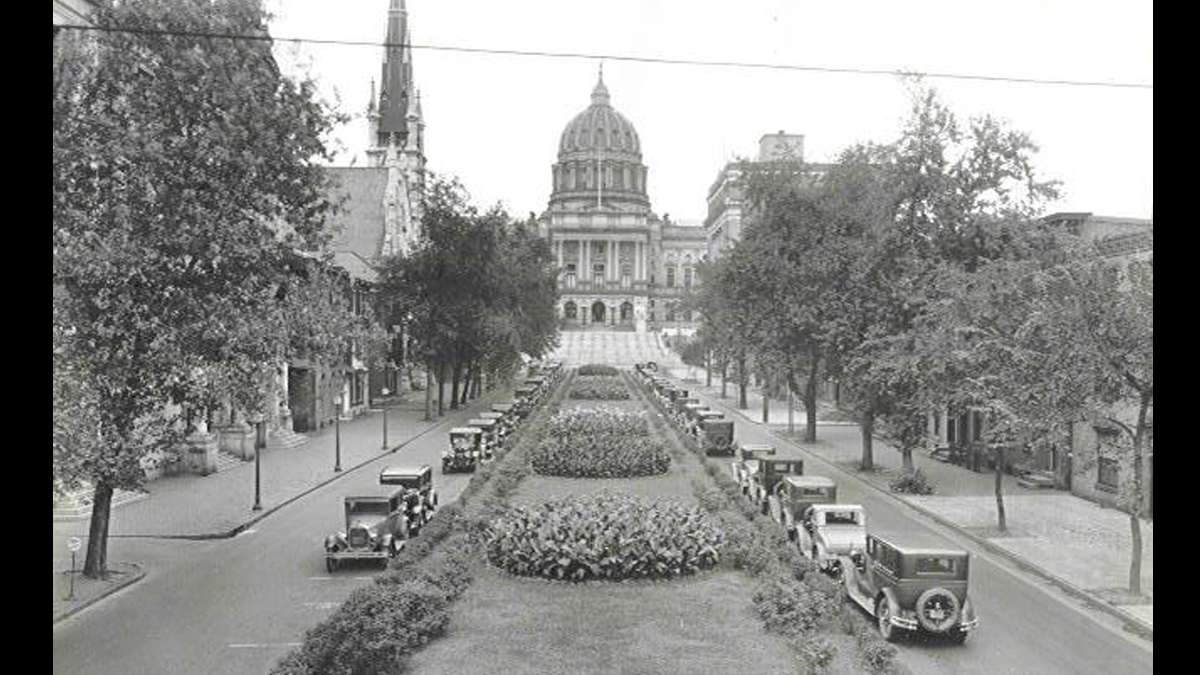Photos: Harrisburg then and now, from Hardscrabble to City Beautiful
Before the City Beautiful movement, Harrisburg was a mess — with antiquated storm water and sewage systems that would drain directly into the river.
Then and Now is an ongoing photographic series from Keystone Crossroads, looking at historical images and photographs of today from Pennsylvania cities and towns.
On December 20, 1900, Mira Lloyd Dock, a botanist, conservationist, and photographer stood before the Board of Trade and showed the group of men a collection of 100 slides from European cities and cities in the U.S. including Milwaukee, Dayton, Boston, Hartford, and their home city of Harrisburg, Pennsylvania. In the slides, Dock showed the scenic river views of the European and American cities contrasted with scenes of garbage and sewage flowing along the Susquehanna River. The contrast of imagery grabbed the attention of the board members and the city’s newspapers and eventually laid the groundwork of what became known as Harrisburg’s City Beautiful movement.
Before the City Beautiful movement, Harrisburg was a mess — with antiquated storm water and sewage systems that would drain directly into the Susquehanna, said Ken Frew, Research Librarian at the Historical Society of Dauphin County. The river was also the source of drinking water for many residents. One of the neighborhoods with a particularly rough reputation was known as Hardscrabble. First home to mostly loggers and then coal dredgers, the riverfront neighborhood was made up of wooden ramshackle houses.

A section of Harrisburg’s Hardscabble neighborhood along Front Street that was torn down around 1922. (Image courtesy of the Historical Society of Dauphin County)
For about 30 years after Dock gave her now famous speech, Harrisburg underwent a transformation. With the support of many city leaders, consultants and J. Horace McFarland of the national City Beautiful movement, Dock helped create a comprehensive plan. The city built a water filtration system, a sewage treatment plant, reservoirs, schools, and a connecting system of parks and preserved green spaces. Streets were paved and street lamps were added. To make way for Riverfront Park, the Hardscrabble neighborhood was demolished, after a court battle.

(Banners hung in front of the Board of Trade promote public improvements during the City Beautiful movement in Harrisburg. (Image courtesy of the Historical Society of Dauphin County)
The list of public works improvements under Dock’s tenure goes on and on and has had lasting impacts on the city.
“The basic layout of the city hasn’t changed. Harrisburg has gone through some rough times in recent years,” said Frew. “But it’s still the same old Harrisburg.”
Jeb Stuart, Chairman of Harrisburg City Beautiful 2.0, a group that brings together non-profits, community groups, and active citizens to encourage and support public works, said there are no major capitol improvement projects underway because of the city’s current financial situation.
But Stuart added that the spirit and the philosophy of the original movement is still alive in Harrisburg.
City Beautiful 2.0 will host a “collective impact” event on Thursday, June 25, from 6-8 p.m. at the Scottish Rite Masonic Cathedral, for community groups and individuals who would like to volunteer or get involved in civic issues like trash cleanup, crime, community gardens and other issues.
(Archival images courtesy of the Historical Society of Dauphin County and the Library of Congress.)
Editor’s note: An earlier version of this article stated that image #24 in the gallery was a photograph of the Devout Mansion. The image shows another historic residence in the same neighborhood, Allison Hill.
WHYY is your source for fact-based, in-depth journalism and information. As a nonprofit organization, we rely on financial support from readers like you. Please give today.































